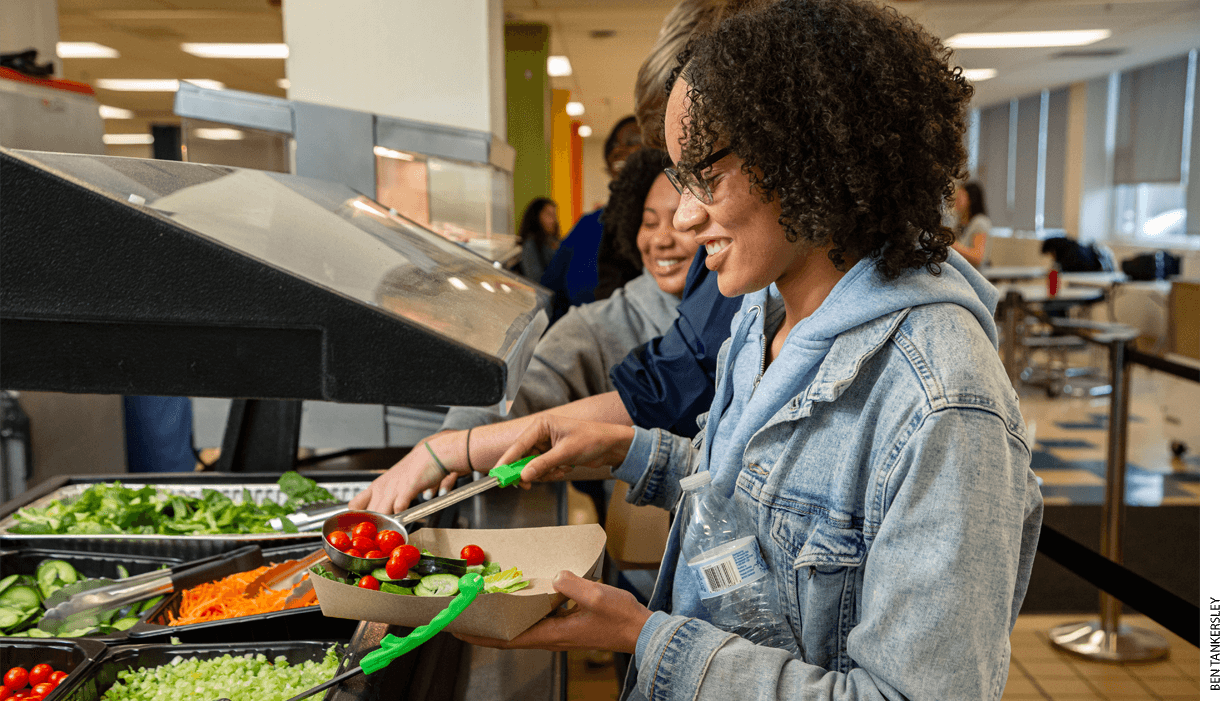
In 2018, after 11th graders at the Capital City Public Charter School in Washington, D.C., researched the “food deserts” plaguing many neighborhoods in their city, they began pressing their cafeteria contractor to make a change: they wanted a salad bar in their school, not just for students but for faculty and staff as well.
The company complied, at first offering the salad bar just two days a week, but eventually providing it on every school day.
This small piece of successful activism aptly illustrates what has happened to service learning, the nearly 40-year-old educational strategy that mixes academics and volunteerism—at times compelled volunteerism. The idea has undergone many permutations, but scholars say it has never been given its due—either by educators or by those who appropriate funds. Today it lives on in an unusual form that rethinks the relationship between academics and service, calling upon students to pose questions about a community problem, research the answers, and devise a fix.
Service learning became popular in the late 1980s and got a boost after the September 11, 2001, attacks, but the philosophy behind it arose nearly a century earlier, articulated by thinkers such as John Dewey. “We must take the child as a member of society in the broadest sense,” Dewey wrote in 1909, “and demand for and from the schools whatever is necessary to enable the child intelligently to recognize all his social relations and take part in sustaining them.”
The practice has always had both supporters and detractors. Supporters point to the benefits young people receive when they learn about their communities’ needs and get involved in serving society.
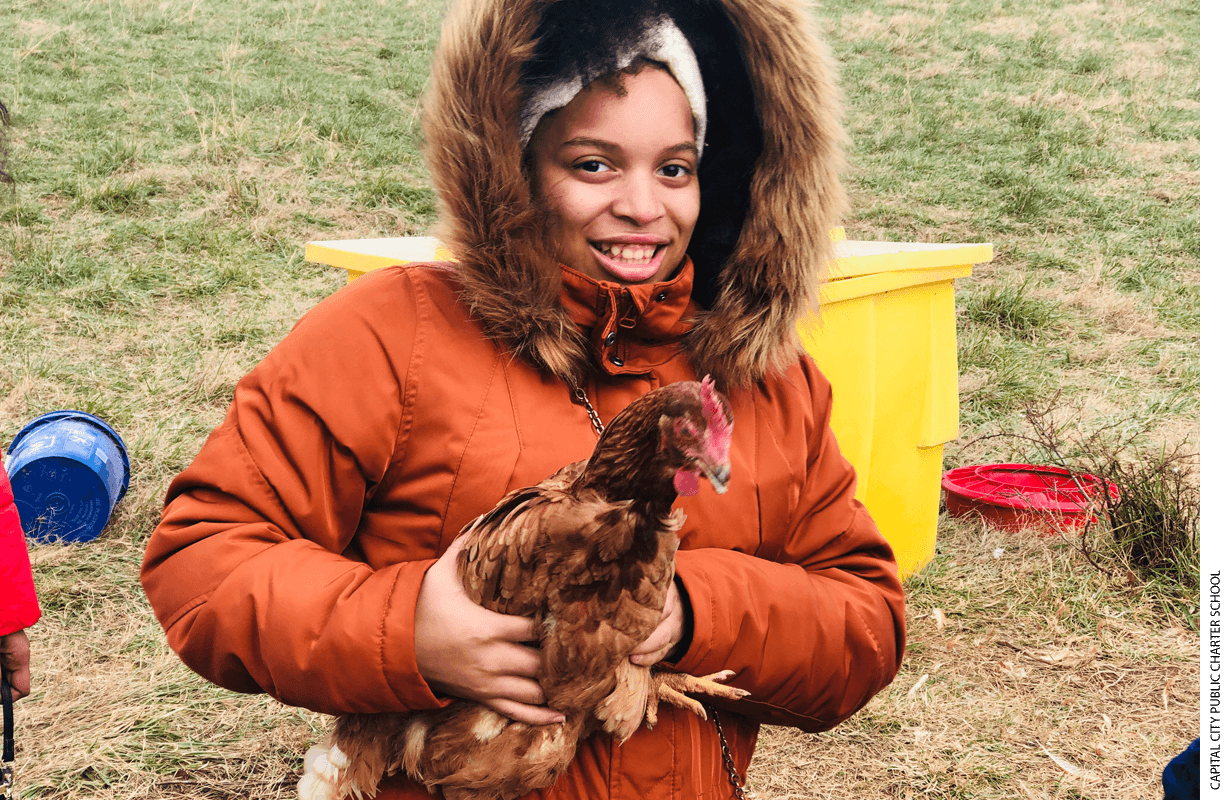
Detractors, though, point to the way in which service learning, which is not always well conceived at the school level, can enlist children in politically fashionable but empirically dubious theories of change. Recent research on “food deserts,” for instance, has suggested that not all low-income neighborhoods are, in fact, parched for nutritious food such as fresh fruits and vegetables. Many of these neighborhoods are as likely as affluent neighborhoods to have well-stocked grocery stores. Research also shows that obesity rates don’t necessarily correlate to the type of food sold in a neighborhood.
Some critics warn that service learning poses the risk of “individualizing” societal problems, that is, of tempting volunteers to believe that the needs they’re addressing—by visiting lonely senior citizens, for instance, or handing out meals to the homeless at a soup kitchen—“reside in the individual” rather than in the system writ large, as one scholar has put it. “It is rewarding for a student to share love, hugs, and mathematics with a student in a tutoring program,” wrote sociologist John W. Eby, “but this individualization of social issues ignores structural components and causes.”
Other critics warn that service learning as it’s often practiced risks politicizing the worthwhile work of volunteering by encouraging students to support left-leaning causes without questioning the assumption that these campaigns are worth backing, or whether it’s the school’s role to do so.
Chester E. Finn, Jr., a former Reagan administration official and president emeritus of the Thomas B. Fordham Institute, a Washington, D.C., education think tank, noted, for instance, that the environmental and nuclear disarmament movements have long relied on children as foot soldiers. He worries about students “getting enlisted in adult causes, as a kind of appealing strike force of winsome children who will be the face of, and kind of pawns in, an adult cause.”
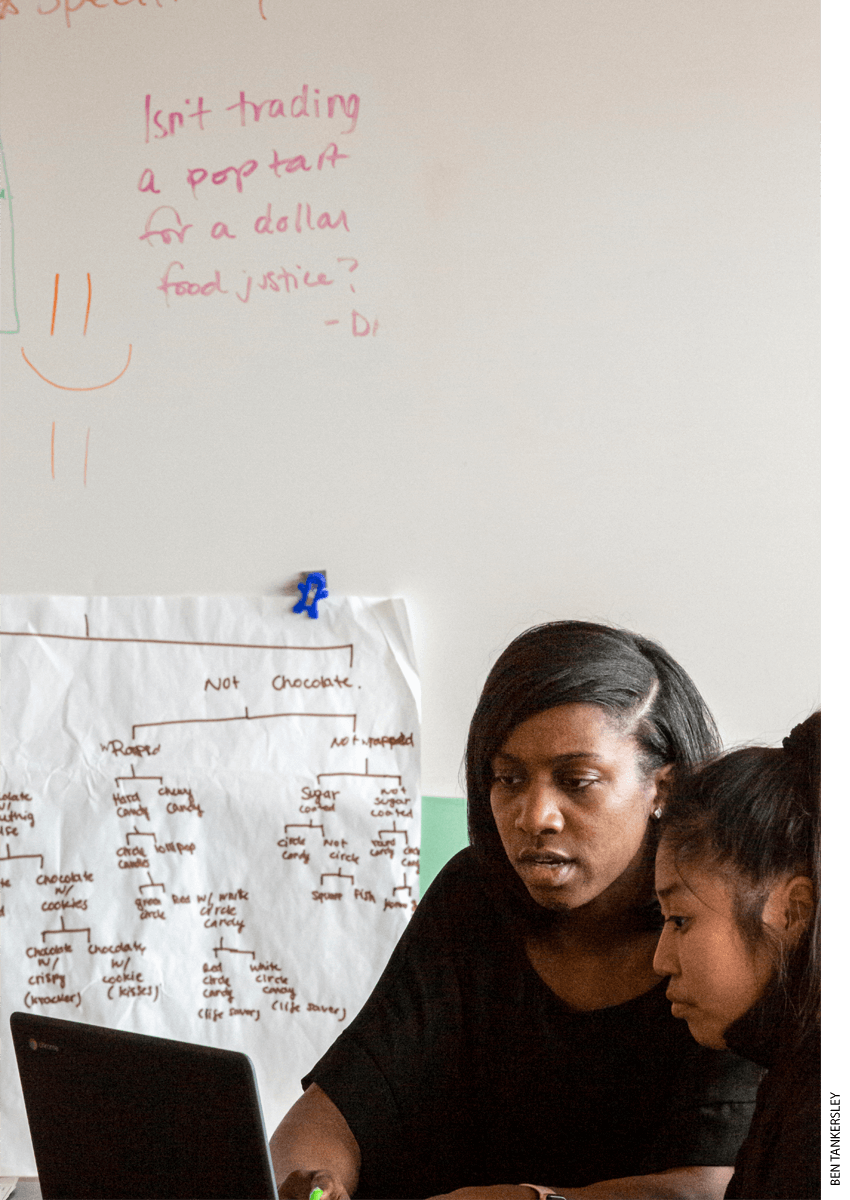
Finn, who also served as a vice chair of the Maryland State Board of Education, said educators should consider the “opportunity cost” of volunteering, since it takes students away from precious instructional time. Nonetheless, he said he’d welcome a well-conceived, post-high-school national service program, which “might actually make a difference in people’s lives and social relations and civic participation.”
Lack of capacity presents a major problem for many high schools that want to include a service-learning component.Leslie Lenkowsky, a University of Indiana researcher and former CEO of the Corporation for National and Community Service, the federal agency that coordinates service, volunteering, and grant-making nationwide, pointed out that classroom teachers have their hands full delivering academic instruction without having to worry about adding a service component.
“A school needs to invest in faculty and staff for service learning,” he said, but most schools don’t have the resources to do it at the scale required.
At the college level, Lenkowsky said, “The faculty has no incentive—I mean no incentive—to build service components into their classes, as a general rule.” They get no additional pay for going the extra mile, he said, and doing so takes away from valuable time for research or scholarship. “The incentive structure does not reward service learning.”
From the student perspective, he said, many college service-learning requirements eventually became the equivalent of having to swim the length of the school swimming pool to graduate. “It’s treated as yet another requirement. It may or may not be well administered.”
In one case, he recalled, college students studying Spanish were required to work in a soup kitchen handing bags of food to Spanish-speaking patrons. “I have no doubt at all they were practicing some Spanish, which was presumably the learning here, but it was pretty rudimentary.”
Lenkowsky said survey results in places like Maryland, which has long made service learning a high school graduation requirement, show that it has little impact on subsequent volunteering rates, often becoming “just another pointless obligation” for students. “In a lot of cases, there’s nobody in the school who can make it a high-quality opportunity. It’s just one more box to check.”
A 2018 report by a Maryland state graduation task force concluded that educators should “revisit the service-learning requirement to ensure that it is a meaningful student experience so that students are likely to actually receive the benefits that research shows it can impart.”
Research has shown that the best predictor of whether a college student will volunteer is membership in a fraternity or sorority, Lenkowsky said. “As part of their social activities, they have built in a service component.” Yet fraternities are increasingly under siege for enabling sexual assault and harassment, and membership in Greek-life organizations has declined in recent years.
McService?
In 1998, the sociologist Eby, who in the 1990s directed service learning at Pennsylvania’s Messiah College, wrote in a widely circulated essay titled “Why Service-Learning Is Bad” that service learning’s limitations are often overlooked and that “possible harm done to communities by short term volunteers is ignored.” Quick-fix programs are analogous to fast food, he wrote, describing the approach as “McService.”
Eby did believe that service learning had “potential to transform teaching and learning,” but he warned that if the movement was to “reach maturity and live up to its potential, it must realistically face its limitations and broaden its emphasis beyond volunteerism,” taking a hard look at just what students learn about social problems and structures.
At the time Eby wrote his missive, another problem was plaguing service learning: a handful of students, upset at graduation requirements that included volunteering, had sued their school districts over service learning, alleging that they amounted to “involuntary servitude,” banned in 1865 under the Constitution’s Thirteenth Amendment, which outlawed slavery.
In the most well-known case, Lynn Ann Steirer and David Stephen Moralis, seniors at the aptly named Liberty High School in Bethlehem, Pennsylvania, challenged a 1990 requirement that students perform 60 hours of unpaid community service during non-school hours. Steirer and Moralis said the graduation requirement also ran afoul of the First Amendment by forcing them to violate their belief that community service should be voluntary.
A federal court disagreed, saying the Thirteenth Amendment prohibited only physical coercion “akin to African slavery.” The three-judge panel concluded: “There is no basis in fact or logic which would support analogizing a mandatory community service program in a public high school to slavery.” Even if the program were mandatory for students, they wrote, it’s not “involuntary servitude” merely because students work without pay.
The judges also said the First Amendment wasn’t violated—while the school district did compel students to volunteer, they wrote, it didn’t force them to express any beliefs about its value.
In the end, all three major lawsuits seeking to block service-learning requirements failed, with federal courts ruling in school districts’ favor.
Nathan Dietz, a senior research associate at the Center on Nonprofits and Philanthropy at the Urban Institute and a researcher with the University of Maryland’s Do Good Institute, spent a decade at the Corporation for National and Community Service from 2002 to 2012, intimately involved with the main federal vehicle for service learning, Learn and Serve America.
Though its budget was much smaller than that of its two sister programs (AmeriCorps and Senior Corps), Learn and Serve America, with an annual appropriation of about $45 million, was nonetheless the largest single source of service-learning funds for U.S. schools. But the funding, Dietz said, was “broken up into such microscopic chunks that it was hard to tell exactly what effect each little chunk of money had on an institution’s ability to do service learning.”
Nonetheless, several meta-analyses of evaluations of service-learning programs have shown that, if done well, they are effective not just at building awareness of issues or sensitivity to cultural differences, but also at promoting cognitive development, academic achievement, and students’ personal insights about social issues. “It’s an intervention that makes regular education work better,” Dietz said.
In 2008, Dietz and his colleagues surveyed school administrators about the kinds of community-oriented programs they operated. About two-thirds of K–12 school principals said their students participated in “community activities,” and 24 percent said their students took part in service learning, down from 32 percent about a decade earlier.
Nineteen percent of principals reported that their school district had a policy that encouraged the integration of service learning into course curricula. Schools in low-income areas were “significantly less likely” to have service-learning activities than other schools—20 percent versus 27 percent overall.
A year later, with interest in public service flagging and one of the program’s main champions, Senator Edward M. Kennedy, ailing from a malignant brain tumor, Congress zeroed out funding for Learn and Serve America.
“On a national level, it’s hard to tell what service learning looks like, especially after Learn and Serve America was defunded,” Dietz said. “A lot of the infrastructure at the state level especially kind of dried up and blew away. It’s a shame, really.”
While service learning never went away, Dietz said, “it became less visible. It doesn’t have the national stature that it used to have.”
It’s nearly impossible to gauge whether service learning has made generations of students more socially conscious or civically engaged, but a few recent data points indicate a general societal drop in giving and volunteering.
Testifying last February before the National Commission on Military, National, and Public Service, Dietz’s colleague Robert T. Grimm Jr., who directs the University of Maryland’s Do Good Institute, noted that 31 states have seen a “significant decline” in volunteering since 2001, in the wake of the September 11 terrorist attacks. The rate of Americans volunteering annually, he said, dropped to an all-time low of 24.9 percent in 2015. Not a single state has seen a significant increase in volunteering since 2001.
Likewise, recent research from the Indiana University’s Lilly Family School of Philanthropy shows a “broad and consistent decline” of more than 13 percentage points in the share of households studied who gave to charity in 2016, compared to 2000. That equals approximately 20 million Americans no longer giving to charitable institutions as of 2016, researchers said. In 2000, 66.2 percent of families gave to charity, but 16 years later, the figure fell to 53.1 percent.
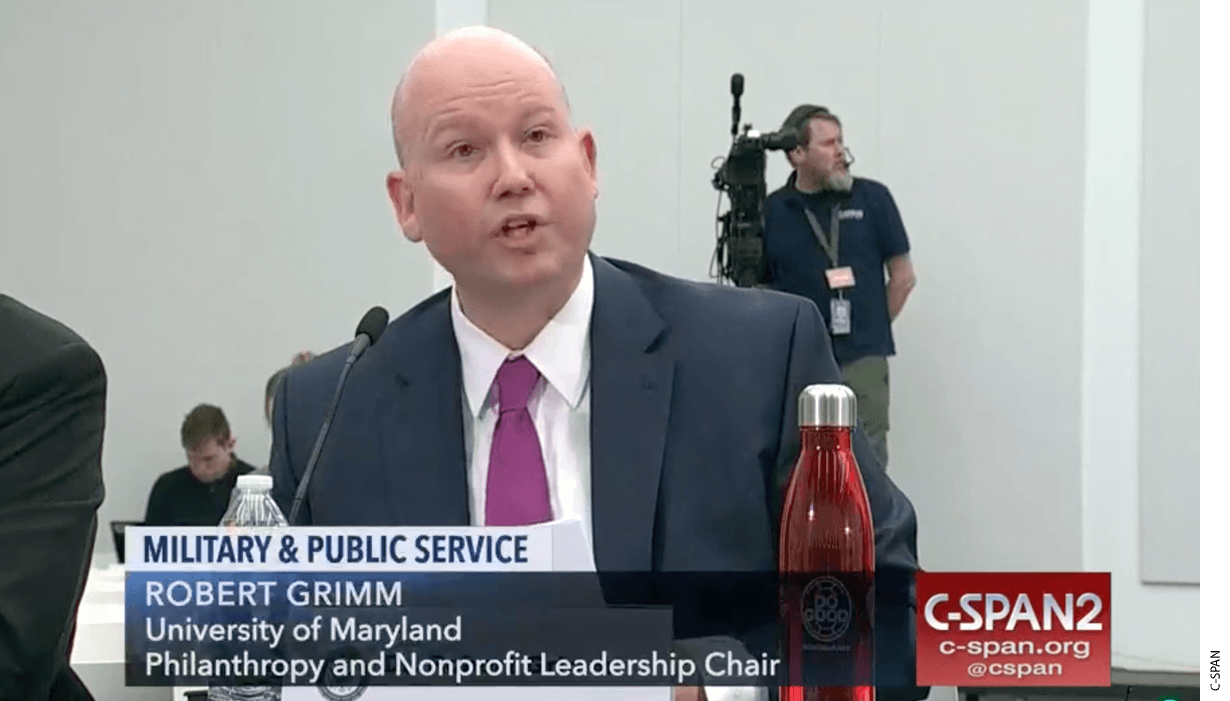
What’s Missing
What’s often missing in service-learning projects, experts say, is context—a reason for students to be of service. Adults who serve their communities often act out of personal values derived from a religious tradition or a deep civic commitment. Service-learning programs in schools, however, often do not provide the exploration of values and society that can motivate people to serve.
James Youniss, a professor emeritus in Catholic University’s psychology department, said that if service-learning programs don’t help students think about the underlying causes of community problems for which they’re volunteering—and don’t invite students to see themselves as part of the solution—the programs won’t have lasting impact.
Unfortunately, he said, a lot of service learning in the past has fit this description for many students. “It doesn’t require commitment on their part, and it doesn’t require coming to grips with who you are in a civic context.”
Youniss, the co-author of a 1997 book about community service and youth social responsibility, said that kind of deeper perspective grows not simply out of volunteering, but out of doing so under the guidance of a group, such as a church, social-justice group, or environmental organization, that holds strong beliefs about these problems.
Youniss cited one successful school initiative that took time to evolve: a now longstanding program at a predominantly African American Catholic school in Washington, D.C., that required students to work in a soup kitchen at least four times a year.
“The teacher made it known from the beginning: ‘You’re doing this because that’s the essence of Catholic social justice. If you’re going to be a serious person in the world, you’re going to understand that if you have any talent at all, you’re going to use it to help others,’” Youniss said.
Nonetheless, he recalled, many students “started off thinking this was a crazy assignment. They didn’t care for it. But as they got to do it more and more, they got to learn about homelessness, they got to meet homeless people. They got to know the people who ran the shelter and the kitchen.”
In the end, Youniss said, “The whole thing resulted in a kind of change of heart in the kids, coming to see that service is a serious thing and that people really needed help and appreciated the help—and that homeless people were really normal people who somehow got off track, through drugs or crime or whatever it might be. They got to empathize with these people, and they got to change their point of view.”
Many alumni went on to careers in public service, some of them citing their experiences at the soup kitchen as life-changing, Youniss said.
At the other end of the socioeconomic spectrum, educators in an upscale suburb of Boston built a service-learning program around an understanding by students that they were, in truth, repaying the community for their individual good fortune. Educators told students, in so many words, “You owe the community a debt of gratitude,” Youniss said. “Your community built this wonderful school for you. It’s coddled you all the way through, up to adolescence, and now it’s time for you to start to think about being a member of a community.”
He recalled that one student, a football star, put off his service until the last minute, eventually being assigned to help an older blind man through a physical-training regimen in the gym. “That was the way he could give back, because he was physically able,” Youniss said.
In the end, the student described the experience as revelatory, tearing up as he brought to mind the contrast between his own physical prowess and the man’s vulnerability.
“He was really moved by this thing,” Youniss said. “When you see it done well, it’s exciting. But most of the time it’s just half-baked.”
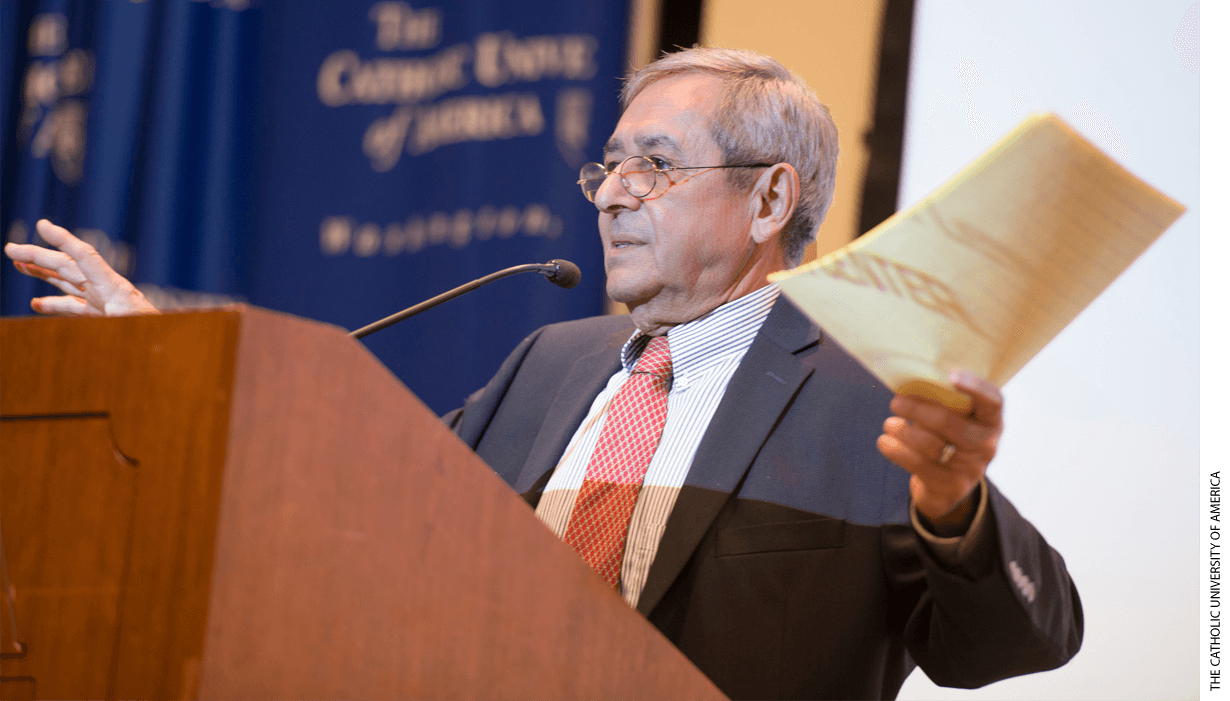
“It’s Just What We Do”
Despite the demise of Learn and Serve America, service learning has continued to evolve, educators say. Most recently, it has been quietly reborn in a handful of project-based schools, many of them committed to approaches like inquiry-based or “deeper” learning. Most notably detailed in the 2014 book Deeper Learning, by Monica R. Martinez and Dennis McGrath, these schools try to help students master essential academic content and think critically, work collaboratively, and solve complex problems. Students are also expected to be the self-directed “leaders of their own educational lives,” the book says.
“There’s been a lot of movement in the last 20 years from what I would call ‘charitable service activities,’” said Ron Berger, founder of EL Education, a Massachusetts-based nonprofit that promotes “challenging, adventurous, and meaningful” schoolwork.
One of the most notable aspects of Berger’s work is this: he has taken the “charitable service” concept and expanded it to everyday academic activities—and to virtually every age group, right down to kindergarten. Under the new conception, he said, deep academic work can complement service—and vice versa.
He noted a recent example in which kindergarteners practiced their handwriting by creating thank-you cards for local firefighters. “It changes everything about the exercise and the intensity of kids, and it sends the message that all the learning you’re doing in school could serve a bigger purpose than just to help you, that you should start now, as five-year-olds, using your learning for good. That’s the most powerful to me, when students feel like, ‘I owe my community and my country a contribution based on what I’m learning. My learning should be contributing to the world in some way.’”
He recalled the recent activities of a 6th-grade class in New London, Connecticut, when the students were learning about refugees and immigrants. Students interviewed newcomers from places like Africa and the Middle East, as well as those who had emigrated to the area decades earlier from Italy, France, Ireland, Switzerland, and other European countries. Then students worked with a professional photographer to take photos of the subjects.
The class created a book and photo exhibit, using the proceeds to underwrite green card applications for new immigrants. Berger said six people so far have gotten green cards with the aid of proceeds from the project.
He said it’s a good example of a lesson that “gets students away from just thinking of themselves, like they’re getting their education just to get rich or get successful, and more like, ‘We owe—we all as human beings—owe each other support. We all should be pitching in.’”
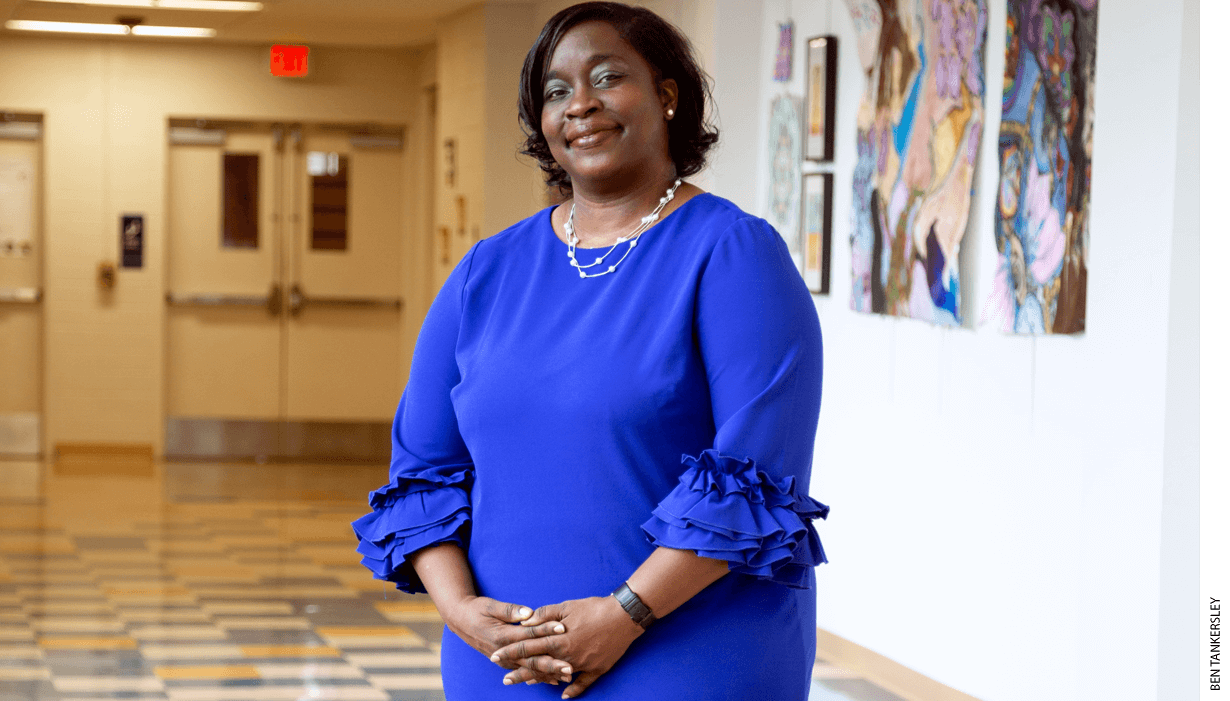
Belicia Reaves, principal of Capital City in D.C., said the students’ salad bar project grew out of an annual “food justice” project that all 11th graders at the school undertake. Its basic question: Why do some D.C. neighborhoods have fresh food while others don’t?
Students visit farms (both rural and urban), farmers’ markets, and orchards and study where their food comes from, many realizing for the first time that little of their food is locally grown. For the past seven years, they’ve hosted a “Food Justice Youth Summit” and now also raise a garden, selling produce once a week.
“It’s a part of the school culture,” she said. “I know it falls under ‘service learning,’ but it is now just what we do.”
Two years ago, in the middle of the project, students on Capital City’s lunch committee began advocating for different lunch options. The result was not just the salad bar but, overall, better-tasting, more locally produced options. “They have the language now,” Reaves said. “They talk about the food ‘traveling further.’”
The project aligned with school’s five “community values,” she said: courage, compassion, contribution, self-discipline, and integrity. “The contribution piece for us is real.”
These days, in order to graduate—actually, in order to move on from 4th, 8th, or 10th grade—students must give presentations about how they’ve made a difference in their community.
“You need to be able to see beyond you,” Reaves said.
EL Learning’s Berger said that most project-based schools shape their programs along these lines, defining projects as those that contribute to society, with academics becoming a routine part of service—in contrast to simply asking students to take time out to do charitable work.
“It’s much more powerful when the work I’m doing in school is in service to doing some good for the world,” he said. “This is where I see the future of service learning going.”
Greg Toppo is the former national education writer for USA TODAY and author of The Game Believes in You: How Digital Play Can Make Our Kids Smarter.
This article appeared in the Summer 2020 issue of Education Next. Suggested citation format:
Toppo, G. (2020). Service Learning in America: From “McService” to “Life Changing”. Education Next, 20(3), 22-28.


